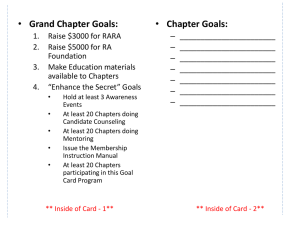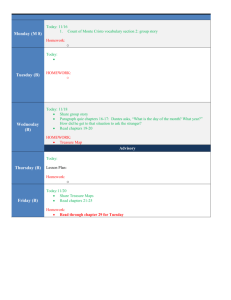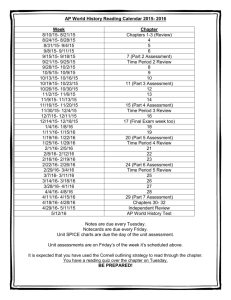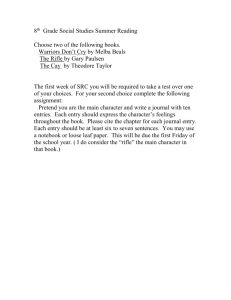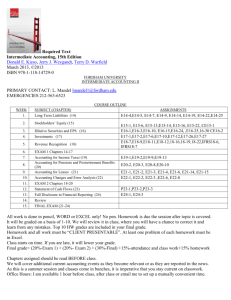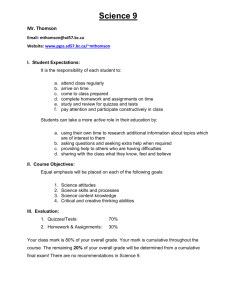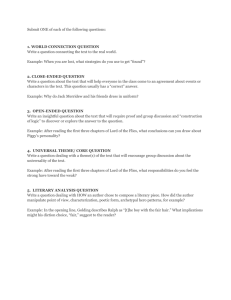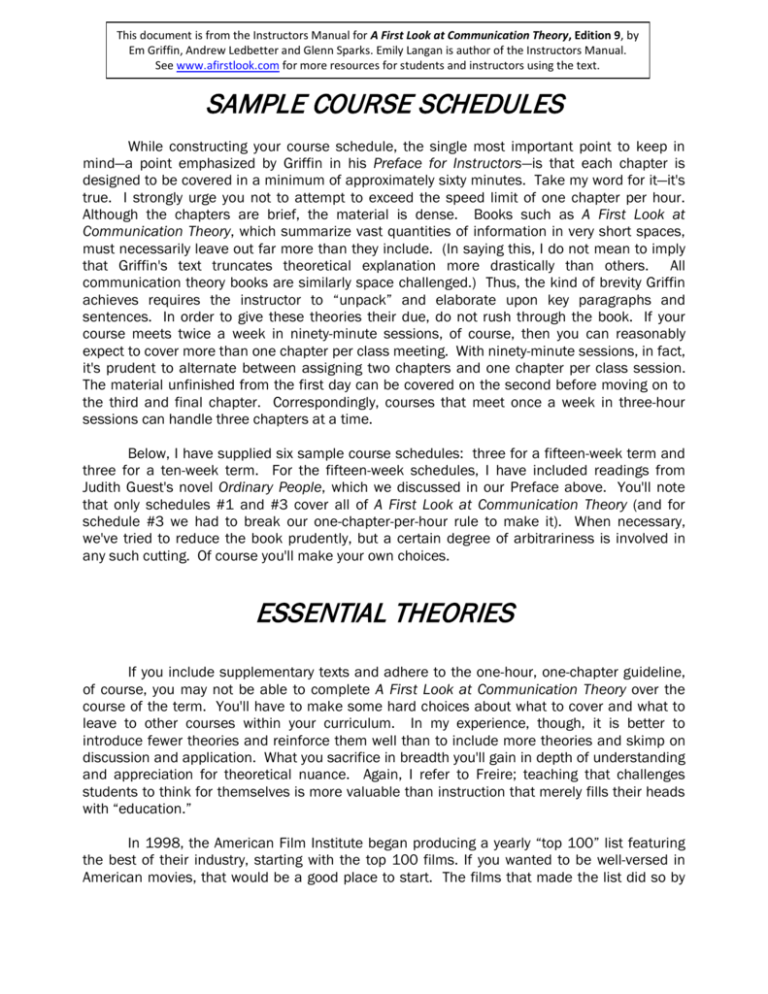
This document is from the Instructors Manual for A First Look at Communication Theory, Edition 9, by
Em Griffin, Andrew Ledbetter and Glenn Sparks. Emily Langan is author of the Instructors Manual.
See www.afirstlook.com for more resources for students and instructors using the text.
SAMPLE COURSE SCHEDULES
While constructing your course schedule, the single most important point to keep in
mind—a point emphasized by Griffin in his Preface for Instructors—is that each chapter is
designed to be covered in a minimum of approximately sixty minutes. Take my word for it—it's
true. I strongly urge you not to attempt to exceed the speed limit of one chapter per hour.
Although the chapters are brief, the material is dense. Books such as A First Look at
Communication Theory, which summarize vast quantities of information in very short spaces,
must necessarily leave out far more than they include. (In saying this, I do not mean to imply
that Griffin's text truncates theoretical explanation more drastically than others. All
communication theory books are similarly space challenged.) Thus, the kind of brevity Griffin
achieves requires the instructor to “unpack” and elaborate upon key paragraphs and
sentences. In order to give these theories their due, do not rush through the book. If your
course meets twice a week in ninety-minute sessions, of course, then you can reasonably
expect to cover more than one chapter per class meeting. With ninety-minute sessions, in fact,
it's prudent to alternate between assigning two chapters and one chapter per class session.
The material unfinished from the first day can be covered on the second before moving on to
the third and final chapter. Correspondingly, courses that meet once a week in three-hour
sessions can handle three chapters at a time.
Below, I have supplied six sample course schedules: three for a fifteen-week term and
three for a ten-week term. For the fifteen-week schedules, I have included readings from
Judith Guest's novel Ordinary People, which we discussed in our Preface above. You'll note
that only schedules #1 and #3 cover all of A First Look at Communication Theory (and for
schedule #3 we had to break our one-chapter-per-hour rule to make it). When necessary,
we've tried to reduce the book prudently, but a certain degree of arbitrariness is involved in
any such cutting. Of course you'll make your own choices.
ESSENTIAL THEORIES
If you include supplementary texts and adhere to the one-hour, one-chapter guideline,
of course, you may not be able to complete A First Look at Communication Theory over the
course of the term. You'll have to make some hard choices about what to cover and what to
leave to other courses within your curriculum. In my experience, though, it is better to
introduce fewer theories and reinforce them well than to include more theories and skimp on
discussion and application. What you sacrifice in breadth you'll gain in depth of understanding
and appreciation for theoretical nuance. Again, I refer to Freire; teaching that challenges
students to think for themselves is more valuable than instruction that merely fills their heads
with “education.”
In 1998, the American Film Institute began producing a yearly “top 100” list featuring
the best of their industry, starting with the top 100 films. If you wanted to be well-versed in
American movies, that would be a good place to start. The films that made the list did so by
having achieved critical acclaim and sustained popular approval, and are considered to have
historical significance and enduring cultural impact. In like fashion, we’ve created our own list
of essentials—theories we believe are indispensable to in a course on communication theory.
Along with Em, Glenn, and Andrew, I’ve created a set of two lists—our top 15 and top 20. If the
demands of your semester require you to scale back the number of theories you can teach,
these lists may be helpful in determining what to include and what to leave out. In addition, I
consider Chapter 1- 4 and 37 essential, no matter how many theories are taught and believe
that every section introduction should be assigned, even if only one theory from that context is
covered. Not surprisingly, our lists have many similarities but also points of departure based
on our own experiences, pedagogical practices, and personal ideologies. The ultimate decision
is up to you, but we hope these lists will stimulate discussion.
Copyright © 2015 McGraw-Hill Education. All rights reserved. No reproduction or distribution without the
prior written consent of McGraw-Hill Education.
Our Essential Theories
Em
Emily
Glenn
Andrew
Symbolic Interactionism (Mead)
6
Coordinated Management of Meaning (Pearce & Cronen)
20
7
Expectancy Violations Theory (Burgoon)
20
20
8
Social Penetration Theory (Altman & Taylor)
20
9
Uncertainty Reduction Theory (Berger)
20
10
Social Information Processing Theory (Walther)
11
Relational Dialectics (Baxter & Montgomery)
12
Communication Privacy Management Theory (Petronio)
13
The Interactional View (Watzlawick)
14
Social Judgment Theory (Sherif)
15
Elaboration Likelihood Model (Petty & Cacioppo)
16
Cognitive Dissonance Theory (Festinger)
17
Functional Perspective on Group Decision Making (Hirokawa & Gouran)
20
18
Symbolic Convergence Theory (Bormann)
19
Cultural Approach to Organizations (Geertz & Pacanowsky)
20
Critical Theory of Comm. Approach to Organizations (Deetz)
21
Constitutive Communication of Organizations (McPhee)
22
The Rhetoric (Aristotle)
20
23
Dramatism (Burke)
20
24
Narrative Paradigm (Fisher)
25
Media Ecology (McLuhan)
26
Semiotics (Barthes)
27
Cultural Studies (Hall)
28
Uses and Gratifications (Katz)
29
Cultivation Theory (Gerbner)
30
Agenda-Setting Theory (McCombs & Shaw)
20
31
Communication Accommodation Theory (Giles)
20
20
32
Face-Negotiation Theory (Ting-Toomey)
20
20
33
Speech Codes Theory (Philipsen)
34
Genderlect Styles (Tannen)
20
20
35
Standpoint Theory (Harding & Wood)
36
Muted Group Theory (Kramarae)
Ch.
5
20
20
20
20
20
Denotes a “top 15” ranking
20 Denotes a “top 20” ranking
Copyright © 2015 McGraw-Hill Education. All rights reserved. No reproduction or distribution without the
prior written consent of McGraw-Hill Education.
Schedule #1
Three One-Hour Meetings per Week for Fifteen Weeks
Covers Every Chapter
(Supplementary Literary Reading Included)
Day Topic
Reading Assignment
1.
Introduction to Course
Open
2.
Launching Your Study
“Introduction” & Chapters 1
3.
Talk about Theory
Chapter 2
4.
Weighing the Words
Chapter 3
5.
Mapping the Territory
Chapter 4
6.
Symbolic Interactionism
“Interpersonal Messages” & Chapter 5
7.
Coordinated Management of Meaning
Chapter 6
8.
Expectancy Violations Theory
Chapter 7
9.
Literary Application
Ordinary People, 1-85
10.
Social Penetration Theory
“Relationship Development” & Chapter 8
11
Uncertainty Reduction Theory
Chapter 9
12.
Social Information Processing Theory
Chapter 10
13.
Relational Dialectics
“Relationship Maintenance” & Chapter 11
14.
Communication Privacy Management
Chapter 12
15.
Interactional View
Chapter 13
16.
Midterm Exam #1
Open
17.
Social Judgment Theory
“Influence” & Chapter 14
18.
Elaboration Likelihood Model
Chapter 15
19.
Cognitive Dissonance
Chapter 16
20.
Literary Application
Ordinary People, 86-171
Copyright © 2015 McGraw-Hill Education. All rights reserved. No reproduction or distribution without the
prior written consent of McGraw-Hill Education.
21.
Functional Perspective
“Group Communication” & Chapter 17
22.
Symbolic Convergence Theory
Chapter 18
23.
Midpoint Integration Discussion
Open
24.
Cultural Approach to Organizations
Chapter 19
25.
Communication Constitutive
Chapter 20
26.
Critical Theory of Organizations
Chapter 21
27.
Rhetoric
“Public Rhetoric” & Chapter 22
28.
Dramatism
Chapter 23
29.
Narrative Paradigm
Chapter 24
30.
Media ecology
“Media and Culture” & Chapter 25
31.
Semiotics
Chapter 26
32.
Cultural Studies
Chapter 27
33.
Midterm Exam #2
Open
34.
Uses and Gratifications
Chapter 28
35.
Cultivation Theory
Chapter 29
36.
Agenda-Setting Theory
Chapter 30
37.
Communication Accommodation
“Intercultural Com.” & Chapter 31
38.
Face-Negotiation Theory
Chapter 32
39.
Speech Codes Theory
Chapter 33
40.
Genderlects Styles
“Gender & Com.” & Chapter 34
41.
Standpoint Theory
Chapter 35
42.
Muted Group Theory,
Chapter 36
43.
Literary Application
Ordinary People, 172-263
Copyright © 2015 McGraw-Hill Education. All rights reserved. No reproduction or distribution without the
prior written consent of McGraw-Hill Education.
44.
Integration
45.
Final Exam
“Communication Theory” & Chapter 37
Copyright © 2015 McGraw-Hill Education. All rights reserved. No reproduction or distribution without the
prior written consent of McGraw-Hill Education.
Schedule #2
Two Ninety-Minute Meetings per Week for Fifteen Weeks
Covers 30 theories
(Supplementary Literary Reading Included)
Day Topic
Reading Assignment
1.
Introduction to Course
Open
2.
Launching Your Study, Talk about
Theory, & Mapping the Territory
“Introduction” & Chapters 1-3
3.
Weighing the Words
Chapter 4
4.
Symbolic Interactionism &
Coordinated Management of Meaning
“Interpersonal Messages” &
Chapters 5- 6
5.
Expectancy Violations Theory
Chapter 7
6.
Literary Application
Ordinary People, 1-85
7.
Social Penetration Theory
Uncertainty Reduction Theory
“Relationship Development &
Chapters 8-9
8.
Midterm Exam #1
Open
9.
Relational Dialectics &
Interactional View
“Relationship Maintenance” &
Chapters 10 & 13
10.
Social Judgment Theory
“Influence” & Chapter 14
11.
Elaboration Likelihood Model &
Cognitive Dissonance
Chapters 15-16
12.
Literary Application
Ordinary People, 86-171
13.
Functional Perspective &
Symbolic Convergence Theory
“Group Decision Making” & Chapters 17-18
14.
Cultural approach to Organizations &
Critical Theory of Organizations
Chapters 20-21
15.
Communicative Constit/ Org
Chapter 20
16.
Rhetoric
“Public Rhetoric” & Chapter 22
Copyright © 2015 McGraw-Hill Education. All rights reserved. No reproduction or distribution without the
prior written consent of McGraw-Hill Education.
17.
Dramatism
Chapter 23
18.
Narrative Paradigm
Chapter 24
19.
Midterm Exam #2
Open
20.
Media Ecology
“Media Effects” & Chapters 25
21.
Semiotics &
Cultural Studies
Chapters 26-27
22.
Cultivation Theory &
Uses and Gratifications
Chapter 29-30
23.
Agenda-Setting Theory
Chapter 31
24.
Communication Accommodation
Face-Negotiation Theory
“Intercultural Com.” & Chapters 31-32
25.
Speech Codes Theory
Chapter 33
26.
Genderlects Styles &
Standpoint Theory
“Gender & Com.” & Chapters 34-35
27.
Muted Group Theory
Chapter 36
28.
Literary Application
Ordinary People, 172-263
29.
Integration
“Communication Theory” & Chapter 37
30.
Final Exam
Copyright © 2015 McGraw-Hill Education. All rights reserved. No reproduction or distribution without the
prior written consent of McGraw-Hill Education.
Schedule #3
One Three-Hour Meeting per Week for Fifteen Weeks
Covers Every Chapter
(Supplementary Literary Reading Included)
Day Topic
Reading Assignment
1.
Introduction and Overview
“Introduction” & Chapters 1-4
2.
Interpersonal Messages
“Interpersonal Messages” & Chapters 5-7
3.
Literary Application &
Relationship Development
Ordinary People, 1-85
“Relationship Development,”&
Chapters 8-10
4.
Relationship Maintenance
“Relationship Maintenance”
& Chapters 11-13
5.
Influence
“Influence,” Chapters 14-16
6.
Group Communication &
Literary Application
“Group Communication,” Chapters 17-18,
& Ordinary People, 86-171
7.
Midterm Exam
Open
8.
Organizational Communication
“Organizational Com.” & Chapters 19-21
9.
Rhetoric
“Public Rhetoric,” Chapters 22-24
10.
Media & Culture
“Media & Culture” & Chapters 25-27
11.
Media Effects, Media Ecology
“Media Effects,” Chapters 28-30
12.
Intercultural Communication
“Intercultural Com.” & Chapters 31-33
13.
Gender & Communication
“Gender & Communication,”
Chapters 34-36,
14.
Integration & Literary Application
“Communication Theory,” Chapter 37, &
Ordinary People, 172-263
15.
Final Exam
Copyright © 2015 McGraw-Hill Education. All rights reserved. No reproduction or distribution without the
prior written consent of McGraw-Hill Education.
Schedule #4
Three One-Hour Meetings Each Week for Ten Weeks
Covers 24 Theories
(No Supplementary Literary Reading Included)
Day Topic
Reading Assignment
1.
Introduction to Course
Open
2.
Launching Your Study &
Talk about Theory
“Introduction” & Chapters 1-2
3.
Weighing the Words
Chapter 3
4.
Symbolic Interactionism
“Interpersonal Messages” & Chapter 5
5.
Coordinated Management of Meaning
Chapter 6
6.
Expectancy Violations Theory,
Chapter 7
7.
Social Penetration Theory
“Relationship Development” & Chapter 8
8.
Uncertainty Reduction Theory
Chapter 9
9.
Relational Dialectics
Chapter 11
10.
Interactional View
“Relationship Maintenance” & Chapter 13
11.
Social Judgment Theory
“Influence” & Chapter 14
12.
Elaboration Likelihood Model,
Chapter 15
13.
Functional Perspective
“Group Decision Making” & Chapter 17
14.
Symbolic Convergence Theory
Chapter 18
15.
Midterm Exam
Open
16.
Cultural Approach to Organizations
“Organizational Com.” & Chapter 19
17.
Critical Theory of Organizations
Chapter 22
18.
Rhetoric
“Public Rhetoric” & Chapter 22
19.
Narrative Paradigm
Chapter 24
Copyright © 2015 McGraw-Hill Education. All rights reserved. No reproduction or distribution without the
prior written consent of McGraw-Hill Education.
20.
Media Ecology
“Media & Culture” & Chapter 25
21.
Cultural Studies
Chapter 27
22.
Uses and Gratifications
Chapter 28
23.
Agenda-Setting Theory
“Media Effects,” Chapter 30
24.
Communication Accommodation
“Intercultural Com.” & Chapter 31
25.
Face-Negotiation Theory
Chapter 32
26.
Speech Codes Theory
Chapter 33
27.
Standpoint Theory
“Gender & Communication” & Chapter 35
28.
Muted Group Theory,
Chapter 36
29.
Integration
“Communication Theory” & Chapter 37
30.
Final Exam
Copyright © 2015 McGraw-Hill Education. All rights reserved. No reproduction or distribution without the
prior written consent of McGraw-Hill Education.
Schedule #5
Two Ninety-Minute Meetings per Week for Ten Weeks
Covers 24 Theories
(No Supplementary Literary Reading Included)
Day Topic
Reading Assignment
1.
Introduction to Course
Open
2.
Launching your study, Talk about
Theory & Weighing the Words
“Introduction” & Chapters 1-4
3.
Symbolic Interactionism
“Interpersonal Messages” & Chapter 5
4.
Coordinated Management of Meaning
& Expectancy Violations Theory
Chapters 6-7
5.
Social Penetration Theory
& Social Information Processing Theory
“Relationship Development”
& Chapter 8, 10
6.
Uncertainty Reduction Theory
Chapters 9
7.
Relational Dialectics
& Interactional View
“Relationship Maintenance”
& Chapters 11 & 13
8.
Social Judgment Theory &
Elaboration Likelihood Model,
“Influence” & Chapters 14-15
9.
Midterm Exam
Open
10.
Functional Perspective &
Symbolic Convergence Theory
“Group Communication” & Chapters 17-18
11.
Cultural Approach to Organizations
“Organizational Com.” & Chapter 19
12.
Critical Theory of Organizations
& Rhetoric
Chapters 20-22 & “Public Rhetoric”
13.
Narrative Paradigm
Chapter 24
14.
Media Ecology & Cultural Studies
“Media & Culture”, Chapter 25, 27
15.
Uses and Gratifications
Chapter 28
16.
Agenda-Setting Function,
“Media Effects,” Chapter 30
Copyright © 2015 McGraw-Hill Education. All rights reserved. No reproduction or distribution without the
prior written consent of McGraw-Hill Education.
17.
Communication Accommodation
& Face-Negotiation Theory
“Intercultural Communication” & Chapters
31-32
18.
Standpoint Theory
“Gender & Communication” & Chapter 35
19.
Muted Group Theory
& Integration
Chapters 36-37
20.
Final Exam
Copyright © 2015 McGraw-Hill Education. All rights reserved. No reproduction or distribution without the
prior written consent of McGraw-Hill Education.
Schedule #6
One Three-Hour Meeting Each Week for Ten Weeks
Covers 21 Theories
(No Supplementary Literary Reading Included)
Day Topic
Reading Assignment
1.
Talk about Theory, Weighing the
Words, & Symbolic Interactionism
“Introduction,” Chapters 1- 5,
& “Interpersonal Messages”
2.
Coordinated Management of Meaning,
Expectancy Violations Theory,
Social Penetration Theory,
Chapters 6-8
“Relationship Development”
3.
Uncertainty Reduction Theory,
Relational Dialectics
& Interactional View
“Relationship Maintenance,”
& Chapters 9, 11, 13
4.
Social Judgment Theory,
Elaboration Likelihood Model
“Influence,” & Chapters 14-15
5.
Midterm Exam
Open
6.
Functional Perspective, Cultural
Approach to Org. & Critical Theory of
Organizations
“Group Communication” “Organizational
Communication,” & Chapters 17,19, 21
7.
Rhetoric, Narrative Paradigm,
& Media Ecology
“Public Rhetoric,” Chapters 22, 24-25
“Media & Culture”
8.
Cultural Studies, Agenda-Setting
Function, Communication
Accommodation
“Media Effects,” “Intercultural
Communication,”
Chapters 27, 30-31
9.
Face-Negotiation Theory, Muted
Group Theory, Integration
Chapters 32, 36, 37, “Gender &
Communication,”
10.
Final Exam
Copyright © 2015 McGraw-Hill Education. All rights reserved. No reproduction or distribution without the
prior written consent of McGraw-Hill Education.

